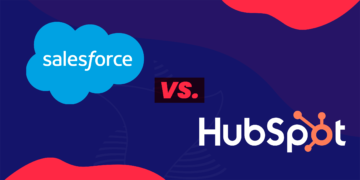Sales and marketing misalignment is one of the most common issues many companies face. In theory, it makes no sense for these two areas to work separately disregarding one another, as they both work for the same goal: driving sales and revenue. Unfortunately, in practice, this is what often happens. Yet, as a marketer and business consultant, I can assure you that putting these two teams up together, working in synergy, is your greatest opportunity to improve your business. When marketing and sales are aligned, you get rid of inefficient processes, your marketing ROI improves and so does your sales productivity. At the end of the day, you will generate more revenue, shorten your sales cycle, increase conversion rates, and improve top-line growth! Don’t believe it? Well, let me present to you four scenarios that I am most certain you have faced or witnessed at some point in your career. Then, I will tell you how sales and marketing alignment helps solving them!
4 Nightmares that sales and marketing alignment can end
1. “The sales team is not following up on the leads marketing sends them”
Unfortunately, according to Marketo and ReachForce, sales ignore 80% of marketing leads and instead spend the majority of their time on unproductive prospecting, such as old leads. So, if sales and marketing align on lead, process, and goals definition, both teams will spend their time more efficiently on higher score leads.
So why do they live in this nightmare instead? Well, there are several explanations, such as the marketing team sending leads in an excel file that sales reps don’t even bother to open, or marketing sending so many unqualified leads that sales reps just give up trying, or even just because due to system configuration sales reps don’t have access to the information they need to follow-up on leads. All of these are easy problems to solve with an integrated system and good communication between teams… But well, the second nightmare responds to some extent to why this problem still exists…
2. “Marketing and sales don’t communicate”
Like in any other relationship, communication is vital. So, sales and marketing teams must schedule meetings to keep track of their goals, sync workflow, overcome obstacles, and share wins. In the selling game, both marketers and sales reps have a voice and together they must define strategies and plan targeted content to nurture the lead at each stage of the funnel.
If marketing is attracting leads without knowing the criteria that make a lead qualified for sales, the most likely outcome is for marketing to be sending leads that sales reps will discard. On the other hand, if sales reps just discard leads without telling marketing why they consider the lead as being unqualified, the situation is never going to get better… so, my big advice is: talk! Define together what you’re looking for and which criteria make a lead a potential client.
3. “There are too many systems on the way”
When you are trying to align sales and marketing is particularly important that both teams use and share the same tools. So, instead of having marketers logging into one system and sales into another, why not having both teams under the same system? This way, and with different permissions, they may share lead information, dashboards, reports, tools, and customer engagement platforms. How wonderful would it be to have sales reps accessing information about lead engagement throughout the funnel and having marketing notifying sales about relevant lead activity? The goal should be to have a system that allows for marketing and sales to work collaboratively on leads, opportunities, and even existing clients up-sell and cross-sell initiatives.
4. “It is difficult to measure marketing ROI”
It is complex to measure marketing ROI since marketing main goal is often to increase the number of closed deals. This is particularly hard to measure for B2B marketers which focus on very long lead generation programs and rely on complex sales processes. So, to better measure marketing ROI, you should track and measure the impact it has on an integrated selling process, crossing both sales and marketing systems. The only way for marketing to prove ROI is by knowing which leads culminated in won business opportunities… that’s impossible to know if marketing is losing track of all leads sent to sales.
And now for the ones addicted to numbers…
- When sales and marketing teams are aligned, closed-won proposals increase by 38%. (Source: Salesforce)
- Companies with sales and marketing alignment lose 38% fewer customers to competitors. (Source: Salesforce)
- Sales and marketing alignment can lead to a 32% increase in year-over-year revenue growth. (Source: Marketo)
- Sales and marketing alignment can lead to 208% growth in marketing revenue. (Source: Marketo)
- Sales and marketing alignment can lead to 38% higher sales win rates. (Source: Marketo)
So, are you convinced already? Good! Let me tell you how to align sales and marketing with a powerful integration between Pardot, Salesforce B2B marketing automation tool, and Sales Cloud!
How to align sales and marketing with Pardot and Salesforce?
As we have seen, in many businesses sales and marketing are still divided. This makes it difficult for technology, automation, and even artificial intelligence to work at its full potential. Fortunately, Salesforce has always been a great defender of the concept “Customer 360” which states that we should holistically connect to customers, joining relevant data and information from all areas to best serve the customer. To unify B2B marketing and sales, Salesforce relies on Pardot and Sales Cloud seamlessly integrated. Let’s understand how!
A unified Sales Process
With the integration between Pardot and Salesforce, it’s possible to define a holistic sales process that goes from the moment in which a new lead is generated to the moment a sales rep closes an opportunity as won, making the lead a new client. As marketing and sales teams are working in the same system, both teams have visibility of how many leads are being generated, how many are being nurtured, which ones are qualified, and which ones should be contacted, unqualified, or converted. This way, the marketing team is capable of following a lead’s path to the final moment of conversion, enabling marketing to understand which campaigns drive more revenue and which type of leads are being unqualified or lost.
Lead Qualification
Thanks to its lead qualification tools, Pardot mitigates the hassle and often tedious task of adding notes and information to your prospects’ profile. In fact, Pardot can put together an enormous amount of data automatically, such as your lead’s company, social data, and recent activity. This is particularly useful for sales reps when they have to reach out to leads.
Besides, Pardot also qualifies leads automatically by grading them according to how well they fit your targeted personas and scoring them based on how interested are they in your products or services. Thus, only the leads that are perceived as qualified by marketing will be contacted by your sales reps, which of course, saves them time and helps them prioritize the leads with the most potential. Both marketing and sales teams end up only focusing on nurturing and selling to qualified leads, moving them through the funnel, until they have become closed deals.
Lead Nurturing
Then, Pardot also relies on lead nurturing mechanisms. And these are key to turn non-sales-ready-leads into super-sales-ready leads! How? By educating and appealing to cooler leads automatically, again freeing up sales reps time to hotter leads. Thus, leads are added to engagement programs or drip campaigns that send email relevant information and content based on user actions, preferences, or a set of time. Nurturing is particularly important since it is the way for leads to progress over the conversion funnel until they become MQLs and are passed to sales reps. Pardot is all about nurturing cold leads into hot leads, qualified and powerful enough to avoid sales reps time to contact cool uninteresting leads.
Lead Assignment
By aligning your sales and marketing in the same system, you can share information about the leads between teams, and also notify your sales reps every time a lead interacts with a valuable marketing asset or campaign. The same goes for sales notifying marketing about unqualified leads or asking for help nurturing leads that are not yet ready to buy. Moreover, the system allows you to define automatic rules to assign marketing leads to specific sales reps or sales queues based on the criteria upon which your sales team is segmented. This way, every time a lead does a valuable action, the sales rep is automatically notified and can immediately contact the lead, decreasing follow-up times and increasing your sales reps rate of success.
Reporting
Finally, reporting is also one of the biggest advantages of Pardot when it comes to marketing and sales alignment. (Spoiler alert: Pardot reporting has bloomed with Pardot Lightning as you will see in a minute). So, Pardot allows marketers and reps to work together from common definitions, for the same goals, measured by common metrics. With Pardot, sales reps and marketers see both the same reports, increasing visibility across the entire sales cycle for both teams.
Therefore, marketing automation can identify the first touchpoint of a closed deal or multi-touch points (relying on the multi-touch attribution models advanced tool), allowing to tie revenue to individual marketing campaigns and give them the corresponding credit. This enables marketers to see the real influence of their efforts. As for sales reps, they gain a clear vision of their opportunities, from its very beginning through the sales funnel, making the lead path and workflows absolutely transparent.
All in the one and only Pardot Lightning App!
A few years ago, Salesforce has created Pardot Lightning that boosted the sales and marketing sync process! Before, in Pardot Classic, marketers needed to open a new tab to access their marketing automation tool, while sales reps, would open a different system: Sales Cloud. With Pardot Lightning, Pardot is now inside Sales Cloud, which makes it even easier for marketers and sales reps to be on the same page.
Here are some of the advantages of Pardot Lightning:
- It allows both sales reps and marketers to log to the same system, to which all have access with more or fewer restrictions that you can define in terms of data visibility.
- It allows for way more customization than Pardot Classic. All your marketing workspace can be personalized, in particularly the dashboards you see just when you first open Pardot!
- Since it is now embedded within Sales Cloud, it allows you to have a 360-degree view of all marketing activities and respective metrics, thanks to Salesforce campaigns and its reports on multi-touch revenue attribution.
- It allows for sales and marketing teams to have visibility over leads, contacts and accounts engagement overtime with marketing assets and campaigns
So, you see, all those nightmares stated above are gone with Pardot and Sales Cloud together, or should I say Pardot Lightning App?
It is of the interest of sales reps to check marketing super qualified leads, for which they must communicate well, using the same system, tracking and aiming at achieving one another’s metrics, while working for common goals!
Almost Final Notes – The secret sauce!
So you have seen how marketing automation tools, in particular Pardot, may help your business aligning marketing and sales teams. Yet, no automation in the world will sync both teams unless:
- They work under the same definitions – Sales reps and marketers must speak the same language. Thus, they need to have settled on a common set of key definitions. I suggest you to first focus on defining key terms directly related to the sales funnel so that both marketers and reps are on the same page on those. In case you are wondering what key definitions are, here are some of them: leads, MQL, SQL, opportunities, and customers.
- They are aware of their targeted personas – It is important to develop a set of personas that match sales reps’ criteria for you to define your perfect lead. As a marketer, I can promise you will be surprised to see how well sales reps know from experience which are the prospects more likely to close a deal. So, selling on your business’s personas is surely a way to sync sales and marketing teams, increase close rates, and value marketing-sourced leads.
- Both teams mutually agree on KPIs – Now, this does not at all mean that sales reps and marketers should be measuring the same metrics, as most of the time, they should not. It only means that a win for sales must be a win for marketing, and the other way around.
Bottom line, how is sales and marketing alignment a win-win?
At this point, it has become pretty clear how this synergy is a win-win. But, if you have not completely figured how yet, now I will further explain it to you.
As for marketers, the more deals they help salespeople closing the more success the overall business will have. That means that there will be more cash-flow running in the company’s departments, in which marketing is included. And companies will certainly want to invest heavily in marketing if it is directly contributing to increasing in closed deals. At the end of the day, the business is richer, the marketing department budget increases, and your salary as a marketer is likely to raise too! So, not only will you be paid more, but you can finally put into action that new campaign that you have always wanted to try. Besides, sales success ends up being also marketing success, and ultimately, marketers will increase their visibility, accountability, and authority. Pretty great, right?
As for sales reps, the same thing: greater alignment, the greater number of closed deals, greater the chance of being above target earnings on their commissions! Besides, salespeople can now enjoy a steady stream of leads that meet the criteria they created together with marketing. Meaning that reps no longer have to do prospecting on their own, cold calling leads that do not matter. So, more sales in less time, a more efficient sales funnel, shorter sales cycles, and as I was saying, more revenue.
I hope this article has been useful to you! Subscribe to Stellaxius Knowledge Center to know more about Salesforce and Pardot! 🙂
SUBSCRIBE KNOWLEDGE CENTER
Subscribe for free to our Knowledge Center to get the latest articles straight to your inbox!






